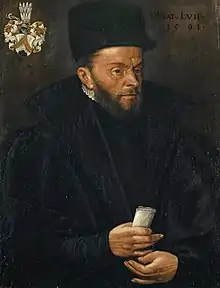Basilius Amerbach the Younger
Basilius Amerbach (1 December 1533 – 25 April 1591) was a lawyer, professor and collector from Basel. He was the only son of Bonifacius Amerbach.
Basilius Amerbach | |
|---|---|
 | |
| Born | 1 December 1533 |
| Died | 25 April 1591 |
| Other names | Basil Amerbach |
| Occupation | Law professor |
| Known for | Amerbach Cabinet |
| Family | Amerbach |
He began to study law in 1552 at the University of Tübingen. In 1553 he studied at the University of Padua where his lecturer was Marcus Mantua Benavidius.[1] 1552, he became a law clerk at the Imperial Chamber Court in Speyer. During this time, Basilius surprised his father by choosing to live with Jacob zur Glocke, a goldsmith, rather than a lawyer.[2] After one year as a clerk, he became a professor at the University of Basel.
Upon Boniface's death in 1562, Basilius inherited his father's Kunstkammer, or "cabinet of curiosities."[3] He expanded the collection of artworks, antiques, coins, and wonders. For the coins he had commissioned a special wooden box.[4] His additions to the "Amerbach Cabinet" also included the equivalent of "the entire contents of at least two goldsmiths' workshops."[2] Basilius took an inventory of his collection in 1586, which contained such notable items as an alleged unicorn horn[2] and fifteen paintings by Hans Holbein the Younger.[3]
From 1588–91, Basilius participated in the excavation of the Augusta Raurica, a Roman archeological site near his home in Basel.[5] He was the first member of the group of humanists researching the site to identify the colony's amphitheatre.[2]
His collection has been on display at the Basel Historical Museum, originally called the Haus zur Mücke, since 1671.[6]
References
- Hagemann, Hans Rudolf (1992). "Rechtsunterricht im 16. Jahrhundert. Die juristischen Vorlesungen im Basler Amerbachnachlaß". Zeitschrift für Neuere Rechtsgeschichte (in Austrian German). pp. 162–190. Retrieved 2022-11-28.
- Smith, Pamela H; Beentjes, Tonny (2010-03-01). "Nature and Art, Making and Knowing: Reconstructing Sixteenth-Century Life-Casting Techniques". Renaissance Quarterly. 63 (1): 128–179. doi:10.1086/652535. ISSN 0034-4338. S2CID 191629279.
- Chamberlain, Arthur Bensley; Holbein, Hans (1913). Hans Holbein the Younger. Vol. 1. Dodd, Mead. p. 85.
In addition to examples of metal-work, ivory carvings, coins, and various objects of decorative art, the collection contained forty-nine paintings, of which fifteen were attributed to Holbein, a sketch-book with eighty-five studies, one hundred and eleven wood-cuts after his designs, the illustrated Praise of Folly, and two copies each of the "Dance of Death" and "Old Testament" woodcuts. Modern criticism has somewhat reduced these numbers.
- Sladeczek, Franz-Josef (2011). Die grosse Kunstkammer: bürgerliche Sammler und Sammlungen in Basel (in German). Historisches Museum Basel. p. 21. ISBN 978-3-85616-539-0.
- Hufschmid, Thomas; Pfäffli, Barbara (2015). Wiederentdeckt! Basilius Amerbach erforscht das Theater von Augusta Raurica [Rediscovered! Basilius Amerbach explored the theater of Augusta Raurica] (in German). Universitätsbibliothek Basel. ISBN 978-3-7965-3506-2.
- "Über das Museum". www.hmb.ch. Retrieved 2016-04-15.